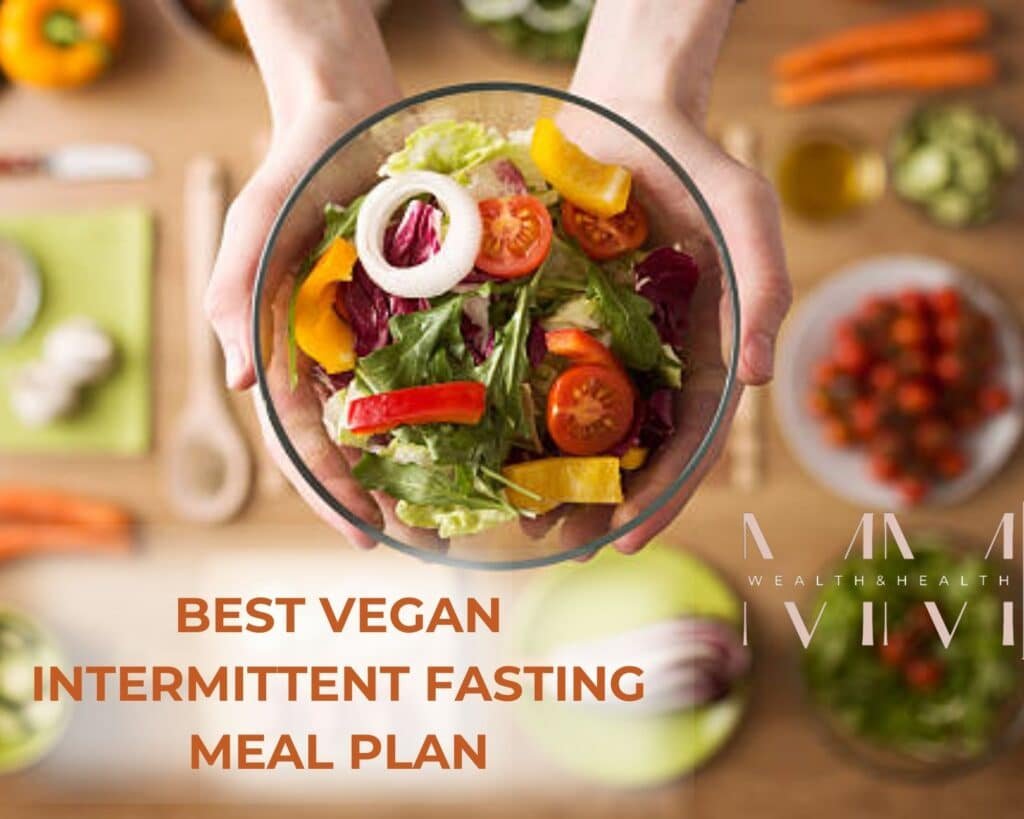Introduction
Intermittent fasting (IF) has emerged as a powerful tool strategy for enhancing overall health and supporting weight loss goals. When combined with a vegetarian diet, this approach offers an abundance of health benefits while aligning perfectly with ethical and environmental considerations. In this comprehensive guide, you will find insightful information, a practical fasting Journey, and helpful tips to navigate a successful vegan intermittent fasting meal plan.
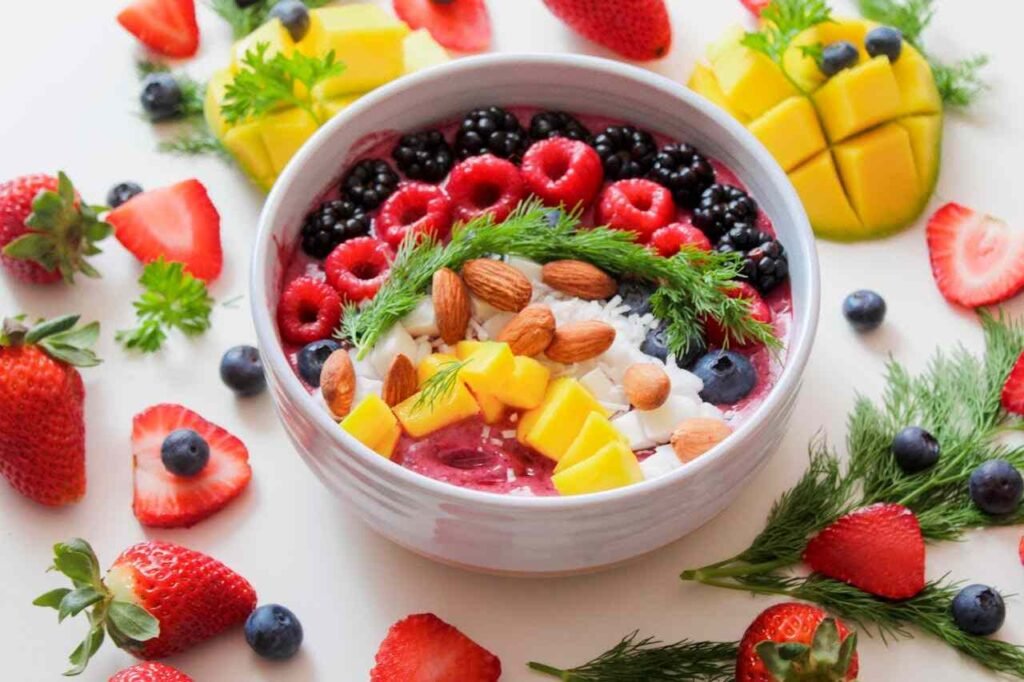
What Is Intermittent Fasting?
Intermittent fasting is more than just an eating pattern, it is an intentional eating framework that contrasts periods of fasting with designated eating windows. Unlike traditional diets that focus heavily on calorie restriction, intermittent fasting places importance on the timing of your meals. This method has gained immense popularity due to its effectiveness in promoting fat loss, enhancing insulin sensitivity, and enhancing metabolic rate.
In recent years, intermittent fasting diet plans have become one of the most sought-after eating patterns, paralleling the explosive growth of veganism, which has surged by 350% over the last decade. Many individuals, particularly those following a plant-based lifestyle, often ponder the compatibility of these two eating trends.

Fortunately, following an intermittent fasting regimen while adhering to a vegan diet is entirely feasible and may offer a range of significant health advantages. These benefits include reduced blood sugar levels, improved cholesterol levels, and a lower risk of serious conditions such as cancer and heart disease.
Common Intermittent Fasting Schedules
1. 16:8 Method: This popular approach involves fasting for 16 hours each day, followed by an 8-hour window during which you consume your meals. This schedule allows flexibility and is often considered one of the easiest methods to maintain long-term.
2. 5:2 Method: In this plan, you eat normally for five days of the week while restricting your calorie intake to approximately 500-600 calories on two non-consecutive days. This method enables a balanced approach to dieting without the need for daily restrictions.
3. Alternate-Day Fasting: This strategy involves alternating between days of regular eating and days of fasting. This pattern can be effective for those who prefer a more varied approach to fasting.
4. Eat-Stop-Eat: This method consists of fasting for a full 24 hours once or twice a week. It offers a robust approach for people who may want a more intensive fasting experience.
5. Warrior Diet: During the Warrior Diet, small amounts of raw, plant-based foods can be consumed throughout the day, followed by a substantial meal within a 4-hour eating window at night. This method is designed for those who thrive on smaller meals during the day but enjoy a larger meal in the evening.
By understanding and integrating these fasting schedules into your vegan lifestyle, you can take full advantage of the benefits that both intermittent fasting and plant-based eating have to offer.
vegan intermittent fasting meal plan
Intermittent fasting, when combined with a vegan diet, creates a powerful synergy that promotes an array of health benefits, making it an exceptional choice for individuals seeking to improve their overall wellness. This approach to eating not only focuses on nourishing the body but also aligns with ethical considerations, providing a comprehensive, wholesome lifestyle with numerous health benefits.
The Vegan Intermittent Fasting meal plan is tailored for everyone who presents a harmonious blend of the principles of intermittent fasting and the nutritional richness of plant-based eating. This thoughtful eating strategy emphasizes the inclusion of plant-based proteins, whole grains, and a variety of nutrient-dense foods, ensuring that every meal is not only satisfying but also rich in essential vitamins and minerals.
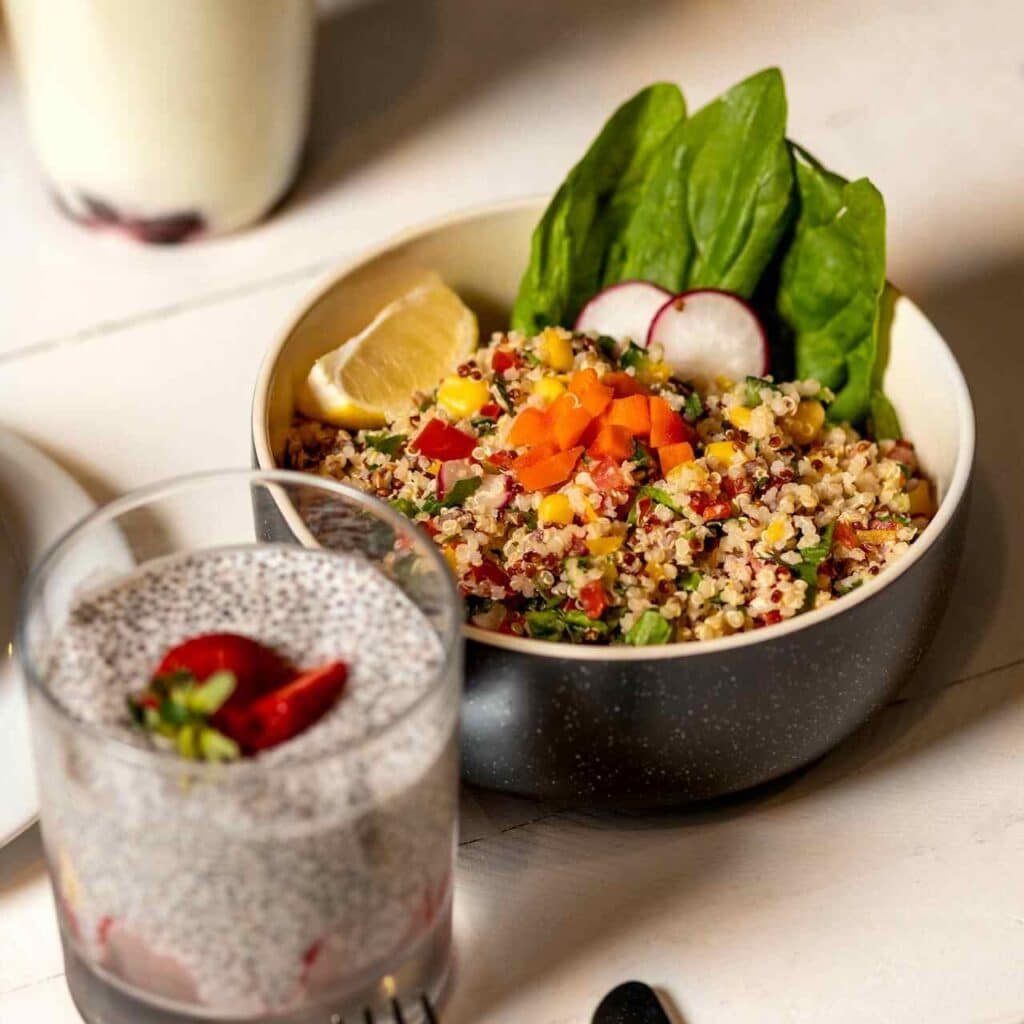
With an array of delicious recipes and meal ideas, following a vegan intermittent fasting meal plan becomes a pleasurable and rewarding experience. This approach encourages healthier eating habits while celebrating the vibrant flavors and textures of vegan cuisine, ultimately leading to a more balanced and fulfilling lifestyle.
Benefits of vegan intermittent fasting meal plan
1. Heart Health
Adopting a plant-based diet alongside intermittent fasting can significantly lower cholesterol levels and decrease the likelihood of developing chronic illnesses, particularly heart disease. The combination encourages a diet rich in heart-healthy nutrients while promoting better cardiovascular function.
2. Weight Loss
Engaging in vegan intermittent fasting facilitates the loss of body fat while helping to maintain lean muscle mass. This approach taps into the body’s ability to burn fat during fasting periods, encouraging a healthier body composition without sacrificing muscle.
3. Improved Nutrient Intake
Focusing on whole foods during eating windows, such as whole grains, healthy fats, and plant-based proteins—creates a nutrient-dense diet. This ensures that your body receives a wide array of vitamins and minerals essential for optimal health.
4. Ethical and Environmental Impact
Embracing a vegan lifestyle not only aligns with ethical considerations about animal welfare but also contributes positively to the environment. By reducing dependence on animal products, individuals help lessen their carbon footprint and promote sustainable living practices.
Why Vegan Intermittent Fasting Works
Calorie Intake Control
This combination aids in regulating calorie consumption. By emphasizing nutrient-dense vegan foods, you can enjoy balanced energy levels throughout the day while avoiding the pitfalls of overeating.

Enhanced Insulin Sensitivity
Intermittent fasting has been shown to help manage blood sugar levels effectively, leading to improved insulin sensitivity. This is especially beneficial for those looking to reduce their risk of developing insulin resistance and related health issues.
Vegan intermittent fasting fosters a long-term approach to health and environmental sustainability. It encourages habits that are not only beneficial for individuals but also for the planet.
Key Components of a Vegan Intermittent Fasting Meal Plan
1. Plant-Based Proteins
To meet your nutritional requirements while following a vegan intermittent fasting meal plan, it’s essential to incorporate a variety of protein-rich foods. Here are some excellent sources of plant-based proteins to consider:
Lentils – Packed with protein and fiber, lentils are versatile and can be used in soups, salads, or as a side dish.
Black Beans – These beans are nutrient-dense and can be enjoyed in tacos, stews, or as a fulfilling salad ingredient.
Chickpeas – Whether you choose them in salads, curries, or blended into hummus, chickpeas offer a robust protein source.
Tofu – A fantastic source of complete protein, tofu can absorb any flavor, making it a great addition to various dishes.
Tempeh – Fermented and packed with probiotics, tempeh is not only protein-rich but also beneficial for gut health.
Seitan – Often referred to as wheat meat, seitan is a high-protein meat alternative that can be used in a variety of savory recipes.
Edamame – Young soybeans are not only a delightful snack but also a rich source of protein and essential amino acids.
Incorporating these elements into your vegan intermittent fasting routine can enhance your health and support your ethical and environmental beliefs.
2. Whole Grains
Whole grains are an excellent source of sustained energy and are packed with essential nutrients that support overall health. Incorporating a variety of whole grains into your diet can help regulate blood sugar levels and improve digestive health. Some nutritious options include:
Brown Rice – This unrefined grain is rich in fiber, B vitamins, and valuable minerals like magnesium and phosphorus. It’s versatile and can be used in stir-fries, salads, and as a side dish.
Quinoa – A complete protein, quinoa contains all nine essential amino acids and is gluten-free. It’s also a good source of magnesium, iron, and fiber, making it a perfect base for salads or a hearty side.
Farro – An ancient grain with a nutty flavor, farro is high in fiber, protein, and nutrients such as iron and zinc. It works well in grain bowls, and soups, and as a substitute for rice or pasta.
Oats – Packed with soluble fiber, oats help lower cholesterol and maintain healthy gut function. They are ideal for breakfast as oatmeal, overnight oats, or smoothies and baked goods.
3. Healthy Fats
Incorporating healthy fats into your diet is essential for optimal brain function, hormone production, and the absorption of fat-soluble vitamins. Here are some excellent sources of healthy fats:
Olive Oil – Rich in monounsaturated fats and antioxidants, olive oil supports heart health and has anti-inflammatory properties. Use it in salad dressings, for sautéing vegetables, or drizzling over roasted dishes.
Avocados – High in monounsaturated fats, fiber, and vital nutrients like potassium and vitamin E, avocados are incredibly versatile. They can be used in salads, spreads, smoothies, or simply enjoyed on toast.
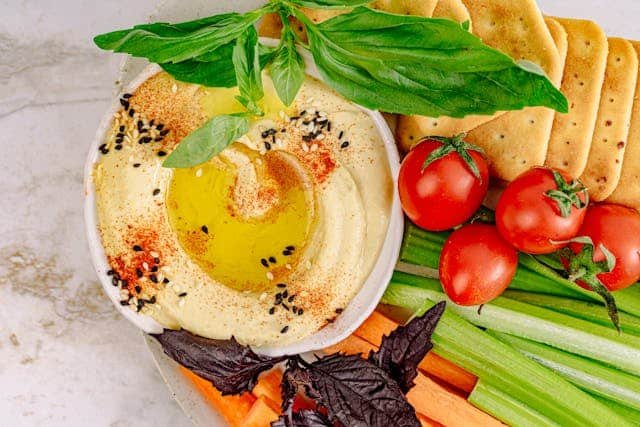
Nuts (Almonds, Walnuts) – Nuts are nutrient-dense and contain healthy fats, protein, and important vitamins and minerals. Almonds are a great snack, while walnuts provide omega-3 fatty acids that are beneficial for brain health.
Seeds (Chia Seeds, Flaxseeds, Sunflower Seeds) – These tiny powerhouses are loaded with omega-3 fatty acids, fiber, and protein. Chia seeds can be added to smoothies or used to make puddings, while flaxseeds are excellent in baking or sprinkled on cereals.
Almond Milk – A dairy alternative that’s low in calories and high in vitamins, almond milk is a great addition to smoothies, coffee, or enjoyed on its own.
4. Nutrient-Dense Foods
Enhancing your meals with colorful fruits and vegetables not only makes your dishes visually appealing but also boosts your intake of essential vitamins and antioxidants. Focus on these key nutrient-dense food sources:
Vitamin C – Essential for immune function and skin health, sources include oranges, strawberries, and bell peppers. Incorporating these into salads or smoothies can add a refreshing twist.
Vitamin D – Crucial for bone health and immune support, fortified plant-based milks and mushrooms are great options to help increase your intake, particularly in less sunny months.
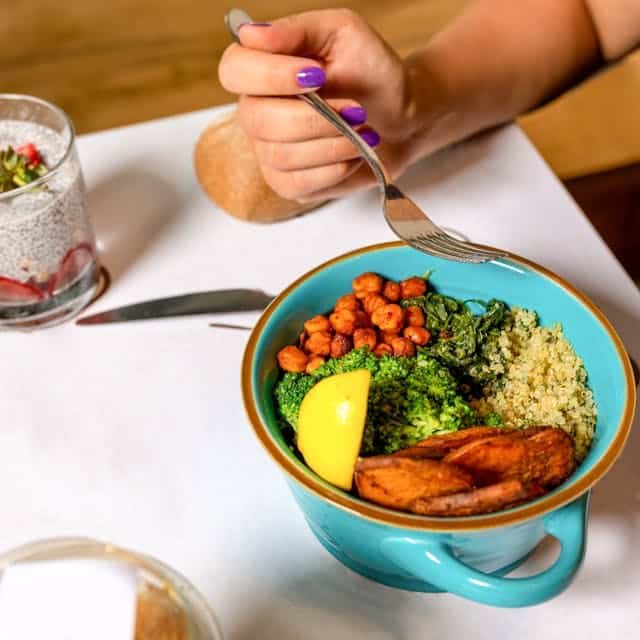
Iron – Necessary for oxygen transport in the blood, iron-rich foods such as spinach, kale, and lentils can enhance energy levels. Pairing them with vitamin C sources can improve iron absorption.
Vitamin B – Important for energy production and overall metabolic function, nutritional yeast and fortified cereals provide a significant boost of B vitamins, especially for those following plant-based diets.
5. Hydration
Staying properly hydrated is vital for overall health and can also assist in regulating appetite. Aim to drink plenty of fluids throughout the day. Use the following strategies to maintain adequate hydration, especially during fasting periods:
Water – The most essential beverage—ensure you’re drinking enough water throughout the day to support digestion and metabolism. Consider infusing your water with fruits or herbs for added flavor.
Herbal Tea – A caffeine-free alternative that can provide hydration along with additional health benefits, depending on the types chosen (e.g., chamomile for relaxation, peppermint for digestion).
Black Coffee – In moderation, black coffee can be a great source of antioxidants and due to its caffeine content, may support metabolism and focus. Drink it without added sugars or cream for the healthiest option.
Sample Vegan Intermittent Fasting Meal Plan (2000 Calories)
Eating Window: 12:00 PM – 8:00 PM
Day 1
Lunch (12:00 PM):
Indulge in a vibrant quinoa salad, featuring fluffy quinoa tossed with protein-packed chickpeas, sweet cherry tomatoes bursting with flavor, refreshing cucumber slices, and a drizzle of rich olive oil for depth. Complement this colorful dish with a side of steamed broccoli, lightly seasoned to enhance its natural taste.
Snack (3:00 PM):
Savor a nutritious handful of mixed nuts, providing a satisfying crunch, paired with a crisp, juicy apple that adds a refreshing sweetness to your afternoon.
Dinner (7:00 PM):
Enjoy a hearty lentil curry, simmered to perfection with an array of spices and served over a bed of fluffy brown rice. This dish is perfectly paired with a side of roasted sweet potatoes, their caramelized edges providing a delightful contrast, alongside a fresh spinach salad tossed with olive oil and lemon for brightness.
Day 2
Lunch (12:00 PM):
Delight in a colorful black bean and sweet potato bowl, featuring tender chunks of roasted sweet potato, creamy avocado slices, and zesty salsa for an extra kick. Each bite is a satisfying mix of textures and flavors, perfect for fueling your day.
Snack (3:00 PM):
Blend a refreshing smoothie using silky almond milk as a base, combining vibrant spinach, tangy frozen berries, and a scoop of vegan protein powder that makes for a nutritious and energizing pick-me-up.
Dinner (7:00 PM):
Relish a stir-fry of marinated tofu, expertly cooked with a medley of crisp vegetables like bell peppers, carrots, and snap peas, all drizzled with a savory soy sauce. Serve this colorful mix over fluffy quinoa, allowing the flavors to meld beautifully.
Day 3
Lunch (12:00 PM):
Wrap your taste buds around a wholesome whole grain wrap, generously spread with creamy hummus and loaded with grilled vegetables such as zucchini, bell peppers, and eggplant, topped with fresh spinach leaves for crunch.
Snack (3:00 PM):
Enjoy crunchy roasted chickpeas, seasoned with a sprinkle of smoked paprika, making for a deliciously addictive and healthy snack that packs a punch of flavor.
Dinner (7:00 PM):
Savor a warm bowl of vegan chili, brimming with black beans, kidney beans, and diced tomatoes, simmered with a blend of aromatic spices. Serve it with a side of crusty whole-grain bread for a fulfilling end to your day.
The above-planned meals are suitable even for those who have an endomorph body type.
Intermittent Fasting for Women – Your Ultimate Guide on Amazon!
Are you ready to unlock the transformative power of intermittent fasting? This must-read Kindle eBook dives into the science-backed benefits of this revolutionary lifestyle, offering practical solutions tailored specifically for women.
Discover how intermittent fasting can:
✅ Boost your metabolism for effective weight management.
✅ Balance hormones, addressing unique female challenges like fluctuations and nutrient timing.
✅ Elevate your energy levels and mental clarity for a more focused, vibrant life.
This guide is more than just theory—it’s packed with:
✨ Step-by-step meal plans designed for your daily routine.
✨ Practical tips to seamlessly integrate fasting into your lifestyle.
✨ Expert advice to make your fasting journey smooth, empowering, and results driven.
Whether you’re aiming to shed a few pounds, sharpen your focus, or embrace a healthier lifestyle, this book is your ultimate companion. Start your journey today and experience how intermittent fasting can transform your body and mind!
Click now to grab your copy on Amazon and begin your empowering adventure!
Tips for Effective Vegan Intermittent Fasting
1. Plan Ahead
Begin your journey by compiling a well-thought-out shopping list that includes a variety of nutritious vegan ingredients. This will not only streamline your grocery shopping experience but also ensure that you have everything you need to create balanced, satisfying meals that cater to your dietary requirements.
2. Optimize Meal Prep
– Batch-Cooking Vegetables: Take advantage of your oven by using a baking sheet to roast a colorful array of vegetables all at once. This method saves time and makes it easy to add flavorful veggies to your meals throughout the week.
– Prepare Grains and Legumes in Advance: Cook up a batch of your favorite grains (like quinoa or brown rice) and legumes (such as lentils or chickpeas) ahead of time. Storing these staples in your fridge means you can quickly assemble delicious and nutritious meals whenever hunger strikes.
3. Monitor Calorie Intake
Keep track of what you eat to ensure you are meeting your nutrient needs while staying within your caloric goals. Using a food diary or an app can help you stay accountable and make informed choices, ensuring you’re fueling your body effectively during your eating windows.
4. Stay Hydrated
Don’t forget to drink plenty of water throughout the day! Staying well-hydrated is vital for overall health, helps to stave off hunger, and supports your body’s digestion processes. Infusing your water with fruits or herbs can make hydration more enjoyable.
5. Listen to Your Body
Pay attention to how you feel during your intermittent fasting regimen. If you notice changes in your energy levels or activity, be flexible and adjust your fasting schedule to align with your body’s needs. Listening to your body’s signals is key to maintaining a sustainable and healthy fasting practice.
1. Is intermittent fasting safe for vegetarians and vegans?
Absolutely! Intermittent fasting can be effectively practiced by both vegetarians and vegans. The key is to make sure you’re meeting your body’s nutritional needs by including a variety of foods that provide essential nutrients, such as protein from sources like legumes, nuts, and seeds, as well as iron and vitamins from leafy greens, fortified foods, and high-quality grains.
2. Can I follow a keto diet with a vegan intermittent fasting plan?
Yes, following a keto diet while adhering to a vegan intermittent fasting plan is entirely possible. The focus should be on incorporating high-fat, low-carbohydrate plant-based foods into your meals. This includes healthy options like creamy avocados, a diverse range of nuts and seeds, and coconut oil, which can help maintain ketosis while adhering to vegan principles.
3. What are the benefits of intermittent fasting for heart health?
Intermittent fasting offers several cardiovascular benefits that can contribute to a healthier heart. It has been shown to help lower cholesterol levels, improve blood sugar regulation, and reduce inflammation, all of which are vital for maintaining optimal heart health. Regular adherence to this eating pattern may help decrease the risk of heart disease and improve overall well-being.
4. How can I avoid side effects like fatigue?
To minimize side effects such as fatigue while practicing intermittent fasting, it’s crucial to consume well-balanced meals during your designated eating periods. Focus on nutrient-dense foods that provide energy and sustenance. Additionally, staying well-hydrated throughout the fasting period can make a significant difference. If fatigue or other symptoms continue to be a concern, it’s advisable to consult a healthcare provider for personalized guidance and support.
Conclusion
Combining intermittent fasting with a vegan diet is the best way to achieve weight loss, enhance metabolic rate, and enjoy numerous health benefits. By following a structured intermittent fasting method, a well-balanced vegan meal plan, and making thoughtful food choices, you can embrace a sustainable and health-enhancing lifestyle.

